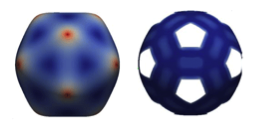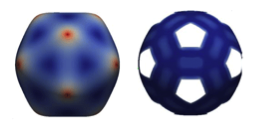Protein Shells Take a Strength Test
To protect their genetic material, viruses surround themselves with a protein shell called a capsid. Most capsids have an icosahedral symmetry (like a -faced die), but large icosahedral capsids have a more faceted shape than smaller ones. As reported in Physical Review Letters, experiments in which viral capsids were poked with an atomic force microscope (AFM) confirm a decade-old prediction for why large icosahedral capsids are so faceted.
The fivefold symmetry of each vertex in an icosahedral capsid is geometrically mismatched with the sixfold symmetry of its surroundings, which creates a built-in tension or “pre-stress.” In 2003, researchers used elasticity theory to show that, because of this pre-stress, capsids larger than a critical diameter should buckle at their vertices, making them more faceted in shape. But elasticity theory is applicable to continuous materials, while capsids are made of discrete protein units, so it wasn’t clear if the predictions would apply to real viruses.
William Klug at the University of California, Los Angeles, and his colleagues took an indirect approach to measuring pre-stress in capsids. With the sensitive tip of an AFM, they measured the force needed to collapse the capsids of herpes simplex virus (a large virus) and found this force was larger if the capsid was intact, compared to if it had holes (missing proteins) at its vertices.
Klug et. al. argue that the pre-stress model is needed to explain the greater stiffness of the intact capsids. The group’s results agree well with predictions based on elasticity theory, suggesting the theory does apply to macromolecular assembly. – Jessica Thomas





